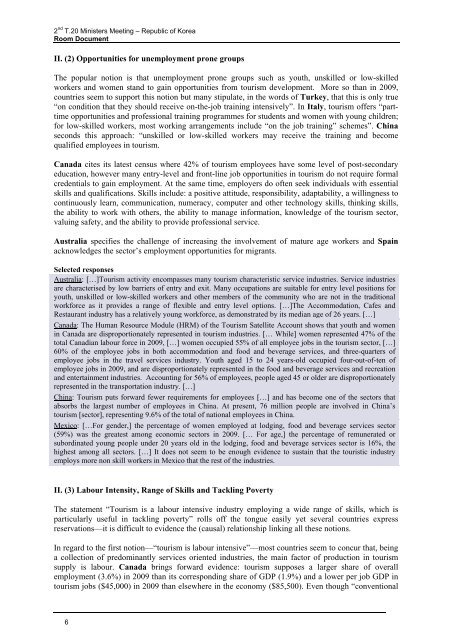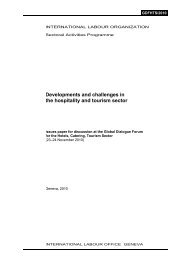Questionnaire on Tourism and Employment: Overview of Results
Questionnaire on Tourism and Employment: Overview of Results
Questionnaire on Tourism and Employment: Overview of Results
You also want an ePaper? Increase the reach of your titles
YUMPU automatically turns print PDFs into web optimized ePapers that Google loves.
2 nd T.20 Ministers Meeting – Republic <strong>of</strong> Korea<br />
Room Document<br />
II. (2) Opportunities for unemployment pr<strong>on</strong>e groups<br />
The popular noti<strong>on</strong> is that unemployment pr<strong>on</strong>e groups such as youth, unskilled or low-skilled<br />
workers <strong>and</strong> women st<strong>and</strong> to gain opportunities from tourism development. More so than in 2009,<br />
countries seem to support this noti<strong>on</strong> but many stipulate, in the words <strong>of</strong> Turkey, that this is <strong>on</strong>ly true<br />
“<strong>on</strong> c<strong>on</strong>diti<strong>on</strong> that they should receive <strong>on</strong>-the-job training intensively”. In Italy, tourism <strong>of</strong>fers “parttime<br />
opportunities <strong>and</strong> pr<strong>of</strong>essi<strong>on</strong>al training programmes for students <strong>and</strong> women with young children;<br />
for low-skilled workers, most working arrangements include “<strong>on</strong> the job training” schemes”. China<br />
sec<strong>on</strong>ds this approach: “unskilled or low-skilled workers may receive the training <strong>and</strong> become<br />
qualified employees in tourism.<br />
Canada cites its latest census where 42% <strong>of</strong> tourism employees have some level <strong>of</strong> post-sec<strong>on</strong>dary<br />
educati<strong>on</strong>, however many entry-level <strong>and</strong> fr<strong>on</strong>t-line job opportunities in tourism do not require formal<br />
credentials to gain employment. At the same time, employers do <strong>of</strong>ten seek individuals with essential<br />
skills <strong>and</strong> qualificati<strong>on</strong>s. Skills include: a positive attitude, resp<strong>on</strong>sibility, adaptability, a willingness to<br />
c<strong>on</strong>tinuously learn, communicati<strong>on</strong>, numeracy, computer <strong>and</strong> other technology skills, thinking skills,<br />
the ability to work with others, the ability to manage informati<strong>on</strong>, knowledge <strong>of</strong> the tourism sector,<br />
valuing safety, <strong>and</strong> the ability to provide pr<strong>of</strong>essi<strong>on</strong>al service.<br />
Australia specifies the challenge <strong>of</strong> increasing the involvement <strong>of</strong> mature age workers <strong>and</strong> Spain<br />
acknowledges the sector’s employment opportunities for migrants.<br />
Selected resp<strong>on</strong>ses<br />
Australia: […]<strong>Tourism</strong> activity encompasses many tourism characteristic service industries. Service industries<br />
are characterised by low barriers <strong>of</strong> entry <strong>and</strong> exit. Many occupati<strong>on</strong>s are suitable for entry level positi<strong>on</strong>s for<br />
youth, unskilled or low-skilled workers <strong>and</strong> other members <strong>of</strong> the community who are not in the traditi<strong>on</strong>al<br />
workforce as it provides a range <strong>of</strong> flexible <strong>and</strong> entry level opti<strong>on</strong>s. […]The Accommodati<strong>on</strong>, Cafes <strong>and</strong><br />
Restaurant industry has a relatively young workforce, as dem<strong>on</strong>strated by its median age <strong>of</strong> 26 years. […]<br />
Canada: The Human Resource Module (HRM) <strong>of</strong> the <strong>Tourism</strong> Satellite Account shows that youth <strong>and</strong> women<br />
in Canada are disproporti<strong>on</strong>ately represented in tourism industries. [… While] women represented 47% <strong>of</strong> the<br />
total Canadian labour force in 2009, […] women occupied 55% <strong>of</strong> all employee jobs in the tourism sector, […]<br />
60% <strong>of</strong> the employee jobs in both accommodati<strong>on</strong> <strong>and</strong> food <strong>and</strong> beverage services, <strong>and</strong> three-quarters <strong>of</strong><br />
employee jobs in the travel services industry. Youth aged 15 to 24 years-old occupied four-out-<strong>of</strong>-ten <strong>of</strong><br />
employee jobs in 2009, <strong>and</strong> are disproporti<strong>on</strong>ately represented in the food <strong>and</strong> beverage services <strong>and</strong> recreati<strong>on</strong><br />
<strong>and</strong> entertainment industries. Accounting for 56% <strong>of</strong> employees, people aged 45 or older are disproporti<strong>on</strong>ately<br />
represented in the transportati<strong>on</strong> industry. […]<br />
China: <strong>Tourism</strong> puts forward fewer requirements for employees […] <strong>and</strong> has become <strong>on</strong>e <strong>of</strong> the sectors that<br />
absorbs the largest number <strong>of</strong> employees in China. At present, 76 milli<strong>on</strong> people are involved in China’s<br />
tourism [sector], representing 9.6% <strong>of</strong> the total <strong>of</strong> nati<strong>on</strong>al employees in China.<br />
Mexico: […For gender,] the percentage <strong>of</strong> women employed at lodging, food <strong>and</strong> beverage services sector<br />
(59%) was the greatest am<strong>on</strong>g ec<strong>on</strong>omic sectors in 2009. [… For age,] the percentage <strong>of</strong> remunerated or<br />
subordinated young people under 20 years old in the lodging, food <strong>and</strong> beverage services sector is 16%, the<br />
highest am<strong>on</strong>g all sectors. […] It does not seem to be enough evidence to sustain that the touristic industry<br />
employs more n<strong>on</strong> skill workers in Mexico that the rest <strong>of</strong> the industries.<br />
II. (3) Labour Intensity, Range <strong>of</strong> Skills <strong>and</strong> Tackling Poverty<br />
The statement “<strong>Tourism</strong> is a labour intensive industry employing a wide range <strong>of</strong> skills, which is<br />
particularly useful in tackling poverty” rolls <strong>of</strong>f the t<strong>on</strong>gue easily yet several countries express<br />
reservati<strong>on</strong>s—it is difficult to evidence the (causal) relati<strong>on</strong>ship linking all these noti<strong>on</strong>s.<br />
In regard to the first noti<strong>on</strong>—“tourism is labour intensive”—most countries seem to c<strong>on</strong>cur that, being<br />
a collecti<strong>on</strong> <strong>of</strong> predominantly services oriented industries, the main factor <strong>of</strong> producti<strong>on</strong> in tourism<br />
supply is labour. Canada brings forward evidence: tourism supposes a larger share <strong>of</strong> overall<br />
employment (3.6%) in 2009 than its corresp<strong>on</strong>ding share <strong>of</strong> GDP (1.9%) <strong>and</strong> a lower per job GDP in<br />
tourism jobs ($45,000) in 2009 than elsewhere in the ec<strong>on</strong>omy ($85,500). Even though “c<strong>on</strong>venti<strong>on</strong>al<br />
6



